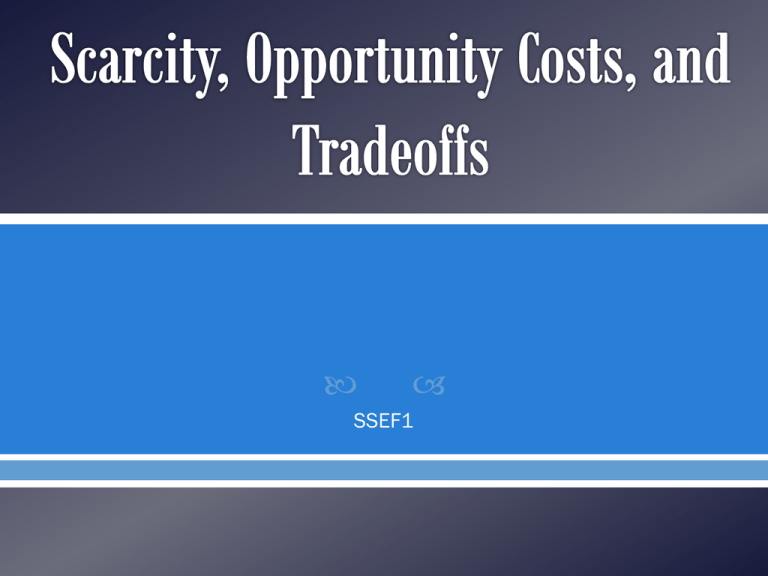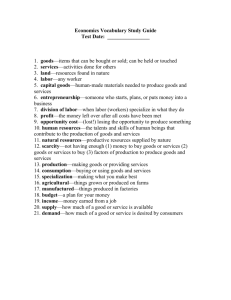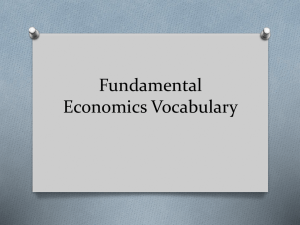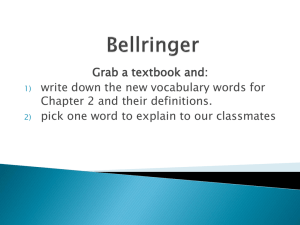SSEF1 - Scarcity, Opportunity Costs, and Tradeoffs
advertisement

SSEF1 Individuals have wants that are, for practical purposes, unlimited. But the total resources of society, including natural resources, human resources, capital goods and entrepreneurship, are limited, so that scarcity exists. As a result, it isn't possible for everyone to have everything he or she wants. No society has ever had enough resources to produce the full amount and variety of goods and services its members wanted. In a world of scarcity, producing any one good or service means that other goods and services cannot be produced, and tradeoffs are inevitable. Scarcity is the condition that exists because human wants exceed the capacity of available resources to satisfy those wants; also a situation in which a resource has more than one valuable use. The problem of scarcity faces all individuals and organizations, including firms and government agencies. Productive resources are used to produce goods and services. Productive resources are classified into four categories. Land Labor Capital Entrepreneurship Land stands for natural resources or gifts of nature such as oil, iron ore, forests and water. Labor refers to human resources. Labor is more than the number of people willing and able to work. Labor also reflects the abilities of people and includes people's health, strength, education, motivation and skills. Capital refers to goods and services such as buildings, equipment, roads, dams and machinery. The level of technology also influences capital. Entrepreneurship is a special kind of labor that represents the characteristics of people who assume the risk of organizing land, labor and capital resources to produce goods and services. Price Majority Rule Contests Force Sharing Lottery Command First come, First served Personal Characteristics Resource goes to those who use market mechanisms such as trade, barter, or price . Great for those who have money or a job with income Not good for those who have little or no income Resource goes to those who win an election; voting; consensus; largest number of people are satisfied Great for those who are popular and those who have many members Not good for the unpopular; those who don’t have the skills to form alliances Resource goes to the most competitive – winner of a race or arm wrestle; survival of the fittest Great for those who are talented and skillful Not good for those who aren’t competitive; unskilled Resource goes to the one who is strongest (physical, mental, political); most forceful Great for those who are strong, powerful, bullish Not good for those who are weak, small, easily intimidated Resource goes to multiple parties by dividing the resource Great in that everyone gets an equal part; no one is left out Not good in that some resources can’t be divided; no party may get enough; not everyone wants some of every resource Resource goes to the luckiest; random; fair Great for those who are lucky and win things; everyone has an equal chance; random winners Not good for those who are unlucky or who “never win anything” Resource goes where directed, ordered, told by another person Great for those who are liked by the commander or if the planner is always fair Not good if the planner isn’t fair Resource goes to the early bird; first in line Great for those who are quick, willing to get ahead of the crowd Not good for the procrastinator; those who are late in planning/ preparing Resource goes to the one with the greatest tenure, the longest hair, the oldest, the youngest, the bluest eyes, etc. Great for those who are able to set the personal characteristic to be awarded the resource Not good for those unable to influence the selection of the characteristic category You have two tickets to the Atlanta Falcons game to give away. The game is sold out. Which allocation strategy would be the best allocation strategy? Which allocation strategy would be the worst allocation strategy? Opportunity cost is what you must give up to obtain something else, the second-best alternative. However, what you must give up to obtain, say, a bicycle is not really money--it is whatever other good or service you would have spent the money on as your next-favorite choice. Similarly, what a government gives up to obtain, say, more educational services is not really money either--it is whatever alternative goods or services the government could have purchased instead, or the goods and services that individuals might have purchased if their taxes had been lower. Opportunity cost includes all costs, including those of time or alternative activities. For example, one part of the opportunity cost of attending college is the money that could have been spent on something else, but another part is the cost in terms of time or alternative activities, when a student could have been working and earning income. As a different example, the opportunity cost for a business of holding a three-hour meeting with 30 employees attending isn't an additional monetary cost, since they are paying the employees already; instead, the opportunity cost of the meeting is the work that could have been accomplished if people hadn't had to attend the meeting. The opportunity cost of the meeting is the next-best alternative use of the time spent at the meeting. A trade-off is the giving up of one benefit or advantage in order to gain another regarded as more favorable.







